Does Massage Gun or Foam Roller Use During a Warm-Up Improve Performance in Trained Athletes?
Abstract
1. Introduction
2. Materials and Methods
2.1. Participants
2.2. Design
2.3. Procedures
2.4. Massage Gun
2.5. Foam Rolling
2.6. Athlete Readiness Questionnaire
2.7. Countermovement Jump Test
2.8. The 10/5 Repeated Jump Test
2.9. The 20 m Sprint Test
2.10. Knee-to-Wall Lunge Test (Ankle Mobility)
2.11. Statistical Analysis
3. Results
4. Discussion
Author Contributions
Funding
Institutional Review Board Statement
Informed Consent Statement
Data Availability Statement
Conflicts of Interest
References
- Afonso, J.; Brito, J.; Abade, E.; Rendeiro-Pinho, G.; Baptista, I.; Figueiredo, P.; Nakamura, F.Y. Revisiting the ‘Whys’ and ‘Hows’ of the Warm-Up: Are we asking the right questions? Sports Med. 2024, 54, 23–30. [Google Scholar] [PubMed]
- McGowan, C.J.; Pyne, D.B.; Thompson, K.G.; Rattray, B. Warm-up strategies for sport and exercise: Mechanisms and applications. Sports 2015, 45, 1523–1546. [Google Scholar]
- Casado, D.; Nacher, I.; Pardo, J.; Reina, J. Effectiveness of a Foam Roller Warm-Up in Professional Basketball Players: A Randomized Controlled Trial. Int. J. Sports Phys. Ther. 2025, 20, 15–29. [Google Scholar] [CrossRef] [PubMed]
- Wiewelhove, T.; Döweling, A.; Schneider, C.; Hottenrott, L.; Meyer, T.; Kellmann, M.; Pfeiffer, M.; Ferrauti, A. A Meta-Analysis of the Effects of Foam Rolling on Performance and Recovery. Front. Physiol. 2019, 10, 449926. [Google Scholar] [CrossRef]
- Ahmed, S.; Jakaria, G.; Islam, M.S.; Imam, M.A.; Ratul, S.K.; Jahangir, R.; Saha, J.; Uddin, J.; Islam, M.J. The comparison of the effects of percussive massage therapy, foam rolling and hamstring stretching on flexibility, knee range of motion, and jumping performance in junior athlete: A randomized controlled trial. Bull. Fac. Phys. Ther. 2024, 29, 44. [Google Scholar] [CrossRef]
- Menek, M.Y.; Menek, B. Effects of percussion massage therapy, dynamic stretching, and static stretching on physical performance and balance. J. Back Musculoskelet. Rehabil. 2024, 37, 183–193. [Google Scholar]
- Leabeater, A.J.; James, L.P.; Huynh, M.; Vleck, V.; Plews, D.J.; Driller, M.W. All the gear: The prevalence and perceived effectiveness of recovery strategies used by triathletes. Perform. Enhanc. Health 2022, 10, 100235. [Google Scholar]
- Ferreira, R.M.; Silva, R.; Vigário, P.; Martins, P.N.; Casanova, F.; Fernandes, R.J.; Sampaio, A.R. The effects of massage guns on performance and recovery: A systematic review. J. Funct. Morphol. Kinesiol. 2023, 8, 138. [Google Scholar] [CrossRef]
- Leabeater, A.J.; Clarke, A.C.; James, L.; Huynh, M.; Driller, M. Under the Gun: Percussive Massage Therapy and Physical and Perceptual Recovery in Active Adults. J. Athl. Train. 2024, 59, 310–316. [Google Scholar] [CrossRef]
- Sams, L.; Langdown, B.L.; Simons, J.; Vseteckova, J. The effect of percussive therapy on musculoskeletal performance and experiences of pain: A systematic literature review. Int. J. Sports Phys. Ther. 2023, 18, 309. [Google Scholar] [CrossRef]
- McCrary, J.M.; Ackermann, B.J.; Halaki, M. A systematic review of the effects of upper body warm-up on performance and injury. Br. J. Sports Med. 2015, 49, 935–942. [Google Scholar] [CrossRef]
- Behm, D.G.; Wilke, J. Do self-myofascial release devices release myofascia? Rolling mechanisms: A narrative review. Sports Med. 2019, 49, 1173–1181. [Google Scholar] [CrossRef]
- Cheatham, S.W.; Kolber, M.J.; Cain, M.; Lee, M. The effects of self-myofascial release using a foam roll or roller massager on joint range of motion, muscle recovery, and performance: A systematic review. Int. J. Sports Phys. Ther. 2015, 10, 827. [Google Scholar]
- Healey, K.C.; Hatfield, D.L.; Blanpied, P.; Dorfman, L.R.; Riebe, D. The Effects of Myofascial Release With Foam Rolling on Performance. J. Strength. Cond. Res. 2014, 28, 61–68. [Google Scholar] [CrossRef] [PubMed]
- Hotfiel, T.; Swoboda, B.; Krinner, S.; Grim, C.; Engelhardt, M.; Uder, M.; Heiss, R.U. Acute effects of lateral thigh foam rolling on arterial tissue perfusion determined by spectral doppler and power doppler ultrasound. J. Strength Cond. Res. 2017, 31, 893–900. [Google Scholar] [CrossRef] [PubMed]
- Aboodarda, S.; Spence, A.; Button, D.C. Pain pressure threshold of a muscle tender spot increases following local and non-local rolling massage. BMC Musculoskelet. Disord. 2015, 16, 265. [Google Scholar] [CrossRef] [PubMed]
- Roberts, T.D.; Costa, P.B.; Lynn, S.K.; Coburn, J.W. Effects of percussive massage treatments on symptoms associated with eccentric exercise-induced muscle damage. J. Sports Sci. Med. 2024, 23, 126. [Google Scholar] [CrossRef]
- Wang, F.; Zhang, Z.; Li, C.; Zhu, D.; Hu, Y.; Fu, H.; Zhai, H.; Wang, Y. Acute effects of vibration foam rolling and local vibration during warm-up on athletic performance in tennis players. PLoS ONE 2022, 17, e0268515. [Google Scholar]
- Padrón-Cabo, A.; Alonso-Calvete, A.; Radzimiński, Ł.; Rey, E.; Lorenzo-Martínez, M. Acute effects of foam rolling vs. vibration foam rolling on blood flow parameters in professional soccer players: A randomized crossover design. J. Strength Cond. Res. 2022, 38, 1885–1890. [Google Scholar]
- Nakamura, M.; Sato, S.; Kiyono, R.; Yoshida, R.; Yasaka, K.; Yahata, K.; Konrad, A. Comparison between foam rolling with and without vibration on passive and active plantar flexor muscle properties. J. Strength Cond. Res. 2022, 36, 3339–3344. [Google Scholar]
- Reiner, M.M.; Glashüttner, C.; Bernsteiner, D.; Tilp, M.; Guilhem, G.; Morales-Artacho, A.; Konrad, A. A comparison of foam rolling and vibration foam rolling on the quadriceps muscle function and mechanical properties. Eur. J. Appl. Physiol. 2021, 121, 1461–1471. [Google Scholar] [CrossRef] [PubMed]
- McKay, A.K.; Stellingwerff, T.; Smith, E.S.; Martin, D.T.; Mujika, I.; Goosey-Tolfrey, V.L.; Sheppard, J.; Burke, L.M. Defining training and performance caliber: A participant classification framework. Int. J. Sports Physiol. Perform. 2021, 17, 317–331. [Google Scholar]
- Drinkwater, E.J.; Latella, C.; Wilsmore, C.; Bird, S.P.; Skein, M. Foam rolling as a recovery tool following eccentric exercise: Potential mechanisms underpinning changes in jump performance. Front. Physiol. 2019, 10, 768. [Google Scholar] [CrossRef]
- McCubbine, J.; Turner, A.; Dos’ Santos, T.; Bishop, C. Reliability and measurement of inter-limb asymmetries in four unilateral jump tests in elite youth female soccer players. Prof. Strength Cond. 2018, 49, 7–12. [Google Scholar]
- Jeffreys, I. Warm up revisited–the ‘ramp’method of optimising performance preparation. Prof. Strength Cond. 2007, 6, 15–19. [Google Scholar]
- Konrad, A.; Glashüttner, C.; Reiner, M.M.; Bernsteiner, D.; Tilp, M. The Acute Effects of a Percussive Massage Treatment with a Hypervolt Device on Plantar Flexor Muscles’ Range of Motion and Performance. J. Sports Sci. Med. 2020, 19, 690–694. [Google Scholar]
- How to Use HYDRAGUN Deep Tissue Massage Gun. Available online: https://blog.hydragun.com/how-to-use-hydragun-deep-tissue-massage-gun/ (accessed on 1 May 2025).
- Matsuo, S.; Iwata, M.; Ujiie, K.; Wada, K.; Asai, Y.; Suzuki, S. Acute effects of the duration of percussive massage on flexibility and muscle force. Sport Sci. Health 2025, 21, 1217–1222. [Google Scholar]
- Behm, D.G.; Alizadeh, S.; Anvar, S.H.; Mahmoud, M.M.I.; Ramsay, E.; Hanlon, C.; Cheatham, S. Foam rolling prescription: A clinical commentary. J. Strength Cond. Res. 2020, 34, 3301–3308. [Google Scholar] [CrossRef]
- Nakamura, M.; Onuma, R.; Kiyono, R.; Yasaka, K.; Sato, S.; Yahata, K.; Fukaya, T.; Konrad, A. The acute and prolonged effects of different durations of foam rolling on range of motion, muscle stiffness, and muscle strength. J. Sports Sci. Med. 2021, 20, 62. [Google Scholar] [CrossRef]
- McLean, B.D.; Coutts, A.J.; Kelly, V.; McGuigan, M.R.; Cormack, S.J. Neuromuscular, endocrine, and perceptual fatigue responses during different length between-match microcycles in professional rugby league players. Int. J. Sports Physiol. Perform. 2010, 5, 367–383. [Google Scholar] [CrossRef] [PubMed]
- Cormack, S.J.; Newton, R.U.; McGuigan, M.R.; Doyle, T.L. Reliability of measures obtained during single and repeated countermovement jumps. Int. J. Sports Physiol. Perform. 2008, 3, 131–144. [Google Scholar] [CrossRef]
- Markovic, G.; Dizdar, D.; Jukic, I.; Cardinale, M. Reliability and Factorial Validity of Squat and Countermovement Jump Tests. J. Strength Cond. Res. 2004, 18, 551–555. [Google Scholar]
- Gathercole, R.; Sporer, B.; Stellingwerff, T.; Sleivert, G. Alternative Countermovement-Jump Analysis to Quantify Acute Neuromuscular Fatigue. Int. J. Sports Physiol. Perform. 2015, 10, 84–92. [Google Scholar] [CrossRef] [PubMed]
- Ramirez-Campillo, R.; Sortwell, A.; Moran, J.; Afonso, J.; Clemente, F.M.; Lloyd, R.S.; Oliver, J.L.; Pedley, J.; Granacher, U. Plyometric-jump training effects on physical fitness and sport-specific performance according to maturity: A systematic review with meta-analysis. Sports Med.-Open 2023, 9, 23. [Google Scholar] [PubMed]
- Ebben, W.P.; Petushek, E.J. Using the Reactive Strength Index Modified to Evaluate Plyometric Performance. J. Strength Cond. Res. 2010, 24, 1983–1987. [Google Scholar] [CrossRef]
- Campos-Vazquez, M.A.; Romero-Boza, S.; Toscano-Bendala, F.J.; Leon-Prados, J.A.; Suarez-Arrones, L.J.; Gonzalez-Jurado, J.A. Comparison of the Effect of Repeated-Sprint Training Combined With Two Different Methods of Strength Training on Young Soccer Players. J. Strength Cond. Res. 2015, 29, 744–751. [Google Scholar] [CrossRef]
- Cormie, P.; McGuigan, M.R.; Newton, R.U. Developing maximal neuromuscular power: Part 1—Biological basis of maximal power production. Sports Med. 2011, 41, 17–38. [Google Scholar]
- Holmberg, P.M.; Olivier, M.H.; Kelly, V.G. The Reliability of 20 m Sprint Time Using a Novel Assessment Technique. Sensors 2025, 25, 2077. [Google Scholar] [CrossRef]
- Cerrillo-Sanchis, J.; Ricart-Luna, B.; Rodrigo-Mallorca, D.; Munoz-Gómez, E.; Domínguez-Navarro, F.; Molla-Casanova, S.; Chulvi-Medrano, I. Relationship between ankle dorsiflexion range of motion and sprinting and jumping ability in young athletes. J. Bodyw. Mov. Ther. 2024, 39, 43–49. [Google Scholar] [CrossRef]
- Powden, C.J.; Hoch, J.M.; Hoch, M.C. Reliability and minimal detectable change of the weight-bearing lunge test: A systematic review. Man. Ther. 2015, 20, 524–532. [Google Scholar] [CrossRef] [PubMed]
- Jones, A.; Brown, L.E.; Coburn, J.W.; Noffal, G.J. Effects of foam rolling on vertical jump performance. Int. J. Kinesiol. Sports Sci. 2015, 3, 38–42. [Google Scholar] [CrossRef]
- Alvarado, F.; Valenzuela, K.A.; Finn, A.; Avila, E.L.; Crussemeyer, J.A.; Nakajima, M. The biomechanical effects of percussive therapy treatment on jump performance. Int. J. Exerc. Sci. 2022, 15, 994. [Google Scholar] [CrossRef]
- Wilke, J.; Müller, A.-L.; Giesche, F.; Power, G.; Ahmedi, H.; Behm, D.G. Acute effects of foam rolling on range of motion in healthy adults: A systematic review with multilevel meta-analysis. Sports Med. 2020, 50, 387–402. [Google Scholar] [CrossRef]
- Payne, K.A.; Berg, K.; Latin, R.W. Ankle injuries and ankle strength, flexibility, and proprioception in college basketball players. J. Athl. Train. 1997, 32, 221. [Google Scholar] [PubMed]
- Zahra, W.; Meacher, H.; Heaver, C. Ankle sprains: A review of mechanism, pathoanatomy and management. J. Orthop. Trauma 2024, 38, 25–34. [Google Scholar] [CrossRef]
- Doherty, C.; Bleakley, C.; Delahunt, E.; Holden, S. Treatment and prevention of acute and recurrent ankle sprain: An overview of systematic reviews with meta-analysis. Br. J. Sports Med. 2017, 51, 113–125. [Google Scholar] [CrossRef] [PubMed]
- Fong, C.-M.; Blackburn, J.T.; Norcross, M.F.; McGrath, M.; Padua, D.A. Ankle-dorsiflexion range of motion and landing biomechanics. J. Athl. Train. 2011, 46, 5–10. [Google Scholar] [CrossRef]
- Coelho, B.A.L.; das Neves Rodrigues, H.L.; Pereira, J.P.S.; de Paula Lima, P.O.; Amado-João, S.M.; Almeida, G.P.L. Immediate effect of a single ankle mobilization session in range of motion, pain and dynamic knee valgus of women with patellofemoral pain and restricted dorsiflexion range of motion: A randomized controlled trial. Phys. Ther. Sport 2021, 47, e3–e4. [Google Scholar] [CrossRef]
- Pearcey, G.E.; Bradbury-Squires, D.J.; Kawamoto, J.-E.; Drinkwater, E.J.; Behm, D.G.; Button, D.C. Foam rolling for delayed-onset muscle soreness and recovery of dynamic performance measures. J. Athl. Train. 2015, 50, 5–13. [Google Scholar] [CrossRef]
- Chen, G.; Gu, Z.; Xin, D.; Qi, Y.; Dai, J. Effect of percussive massage treatment and static stretching on muscle tone, stiffness, and strength recovery after exercise-induced muscle fatigue: A randomized controlled study. Sports Med. Health Sci. 2025. [Google Scholar] [CrossRef]
- Li, H.; Luo, L.; Zhang, J.; Cheng, P.; Wu, Q.; Wen, X. The effect of percussion massage therapy on the recovery of delayed onset muscle soreness in physically active young men—A randomized controlled trial. Front. Public Health 2025, 13, 1561970. [Google Scholar] [CrossRef] [PubMed]
- Dana, E.; Arabacı, R.; Arabacı, M. The Impact of Foam Rolling on Recovery and Performance Components (ROM, Strength, Jump, Agility): A Systematic Review. Pamukkale J. Sport Sci. 2025, 16, 253–270. [Google Scholar] [CrossRef]
- Collings, T.J.; Lima, Y.L.; Dutaillis, B.; Bourne, M.N. Concurrent validity and test–retest reliability of VALD ForceDecks’ strength, balance, and movement assessment tests. J. Sci. Med. Sport 2024, 27, 572–580. [Google Scholar] [CrossRef]
- Altmann, S.; Ruf, L.; Backfisch, M.; Thron, M.; Woll, A.; Walter, L.; Kaul, D.; Bergdolt, L.; Härtel, S. Assessing maximal sprinting speed in soccer–criterion validity of commonly used devices. Sci. Med. Football 2024, 20, e0325611. [Google Scholar] [CrossRef] [PubMed]
- Ferreira, R.M.; Martins, P.N.; Goncalves, R.S. Effects of self-myofascial release instruments on performance and recovery: An umbrella review. Int. J. Exerc. Sci. 2022, 15, 861. [Google Scholar] [CrossRef] [PubMed]
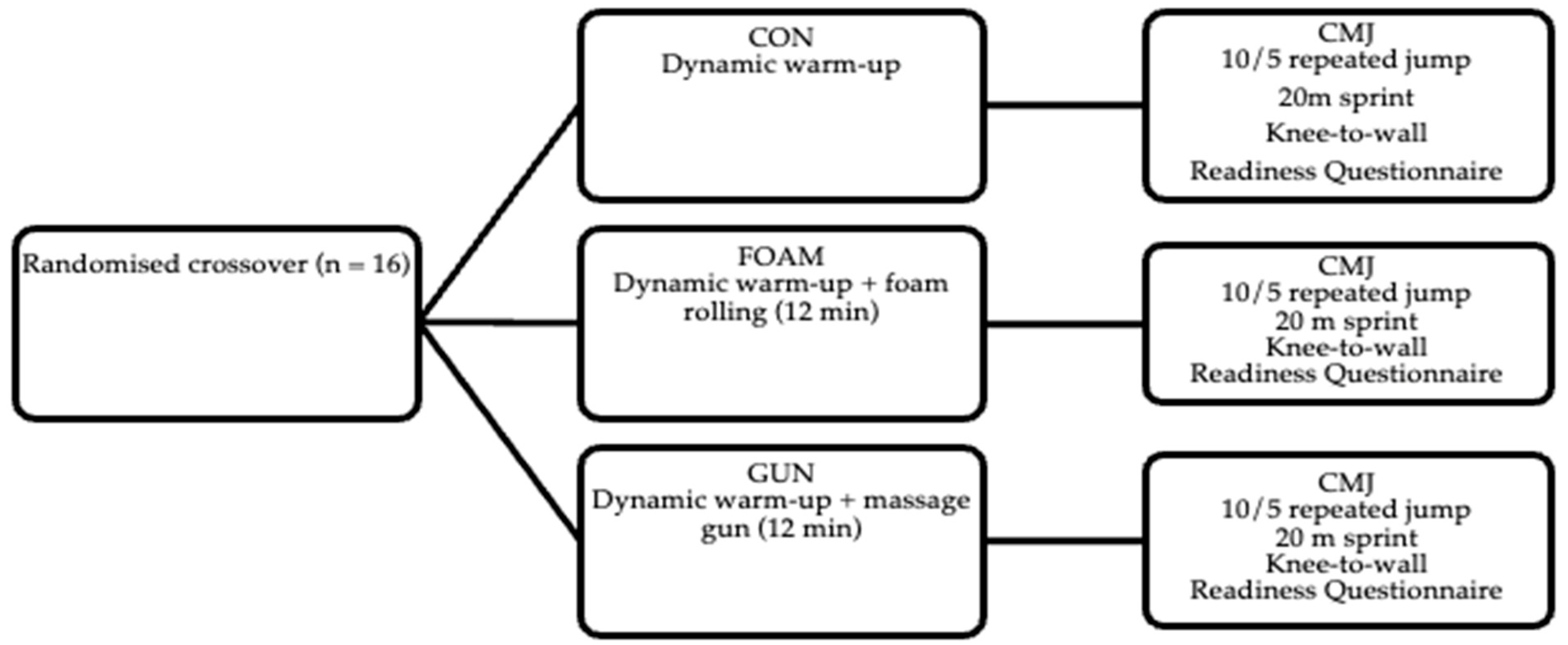
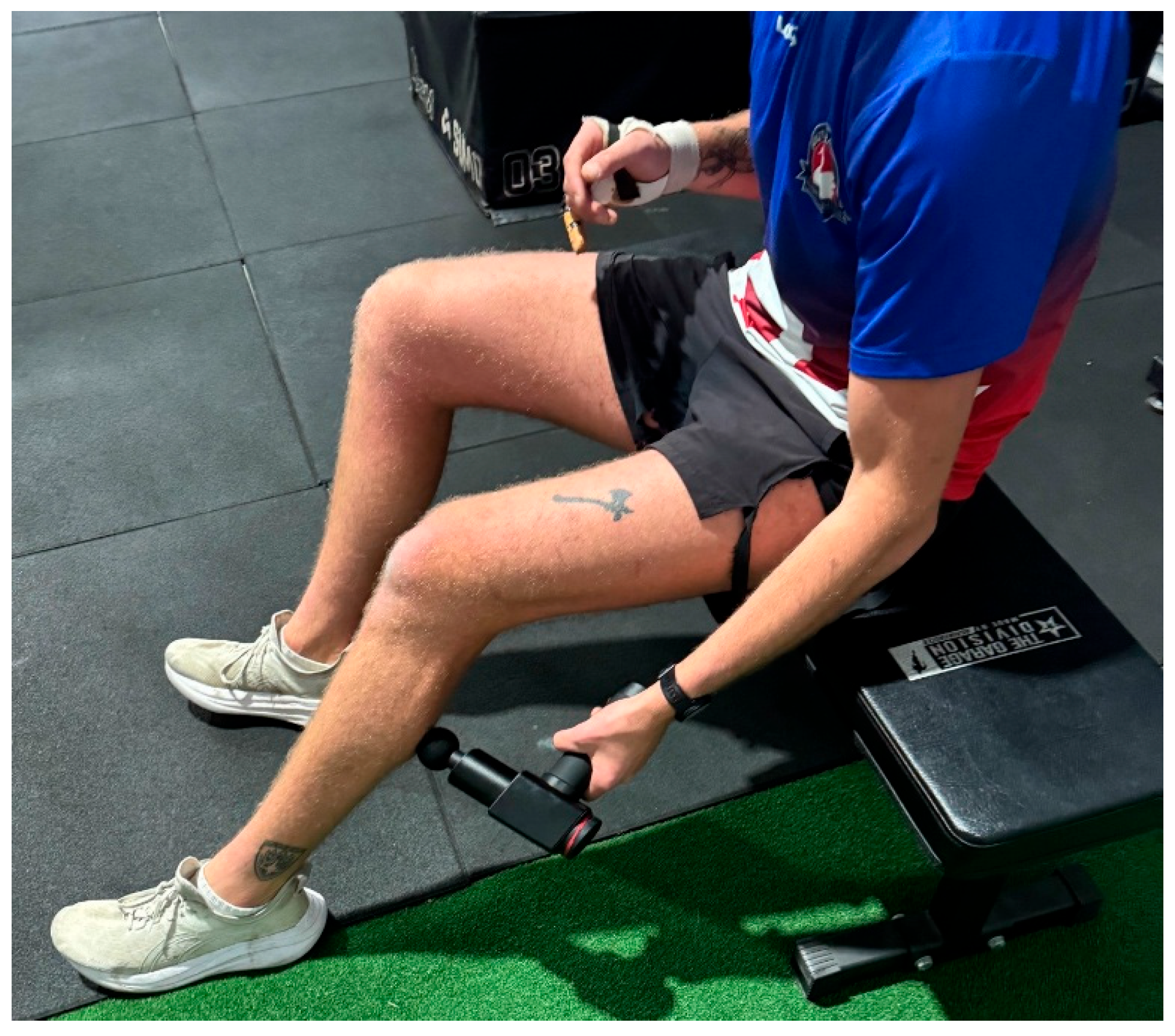
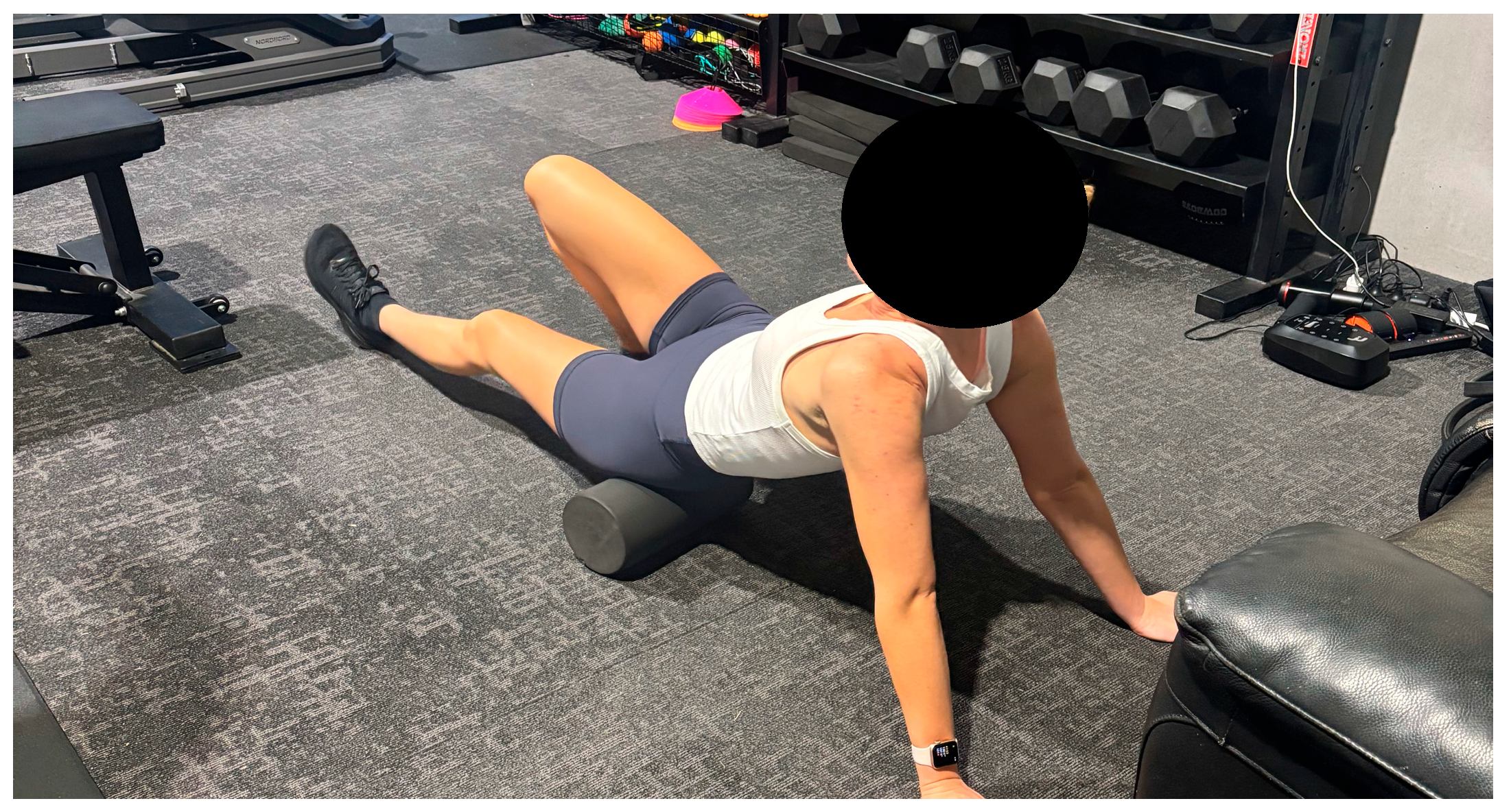
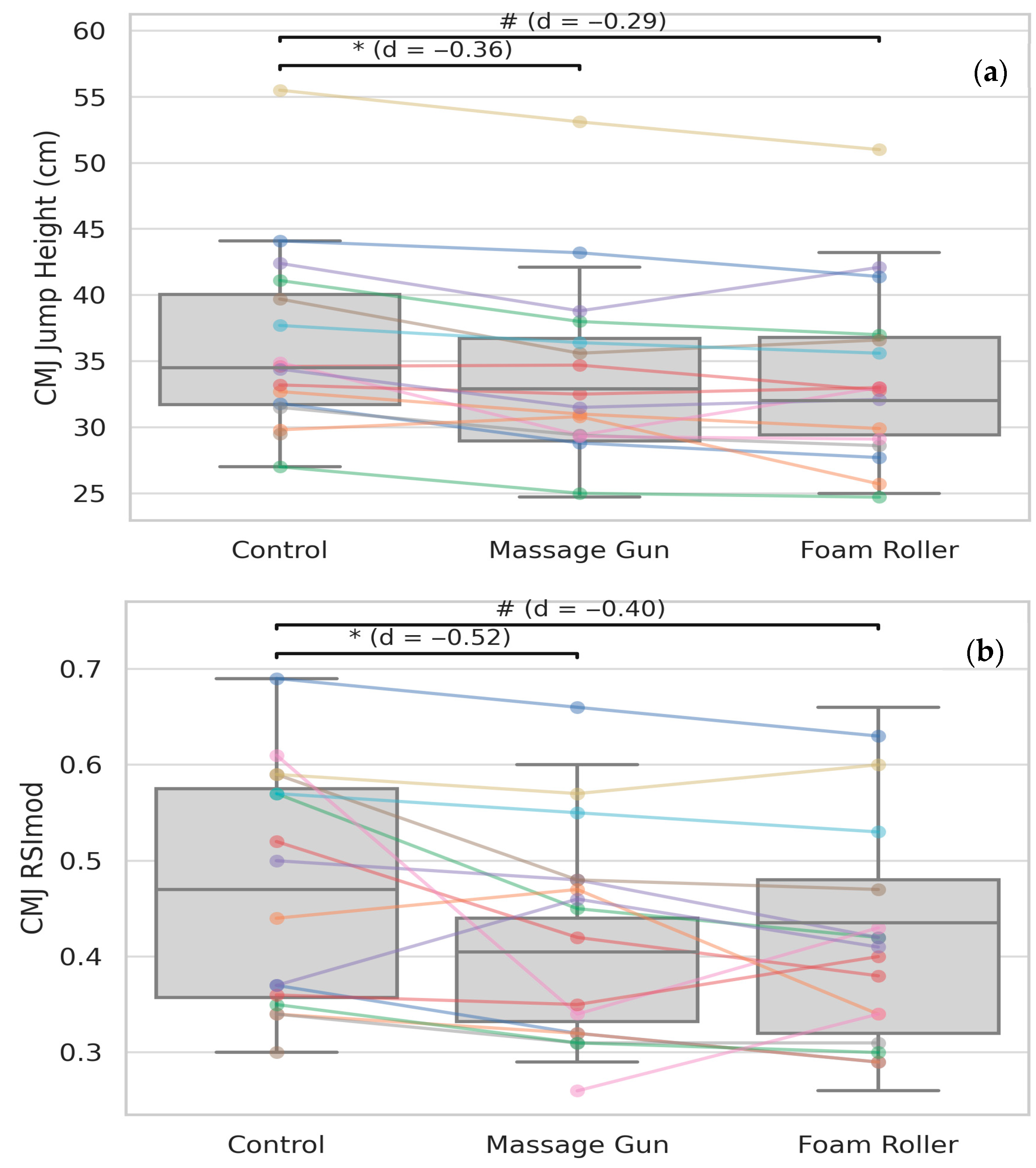
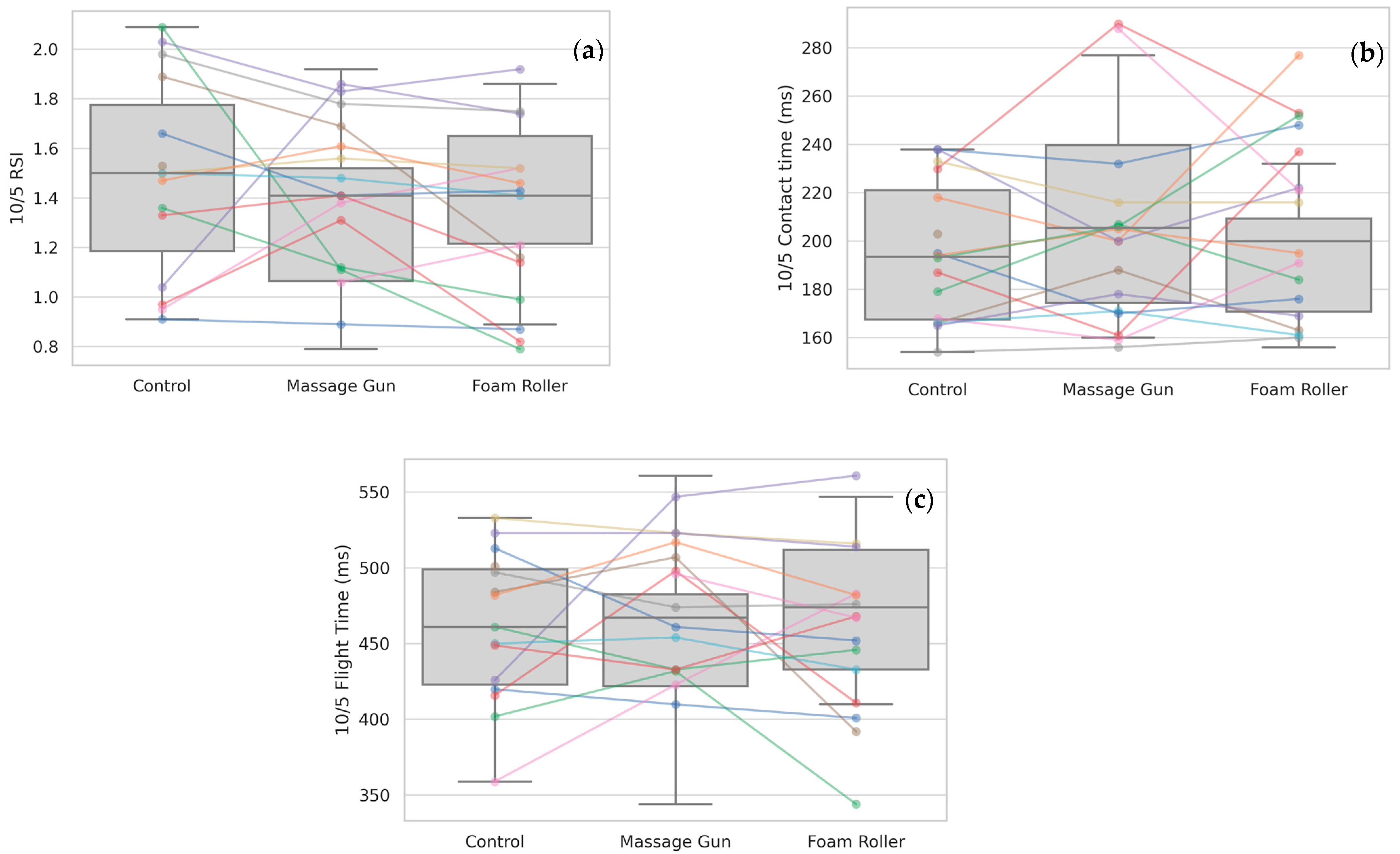
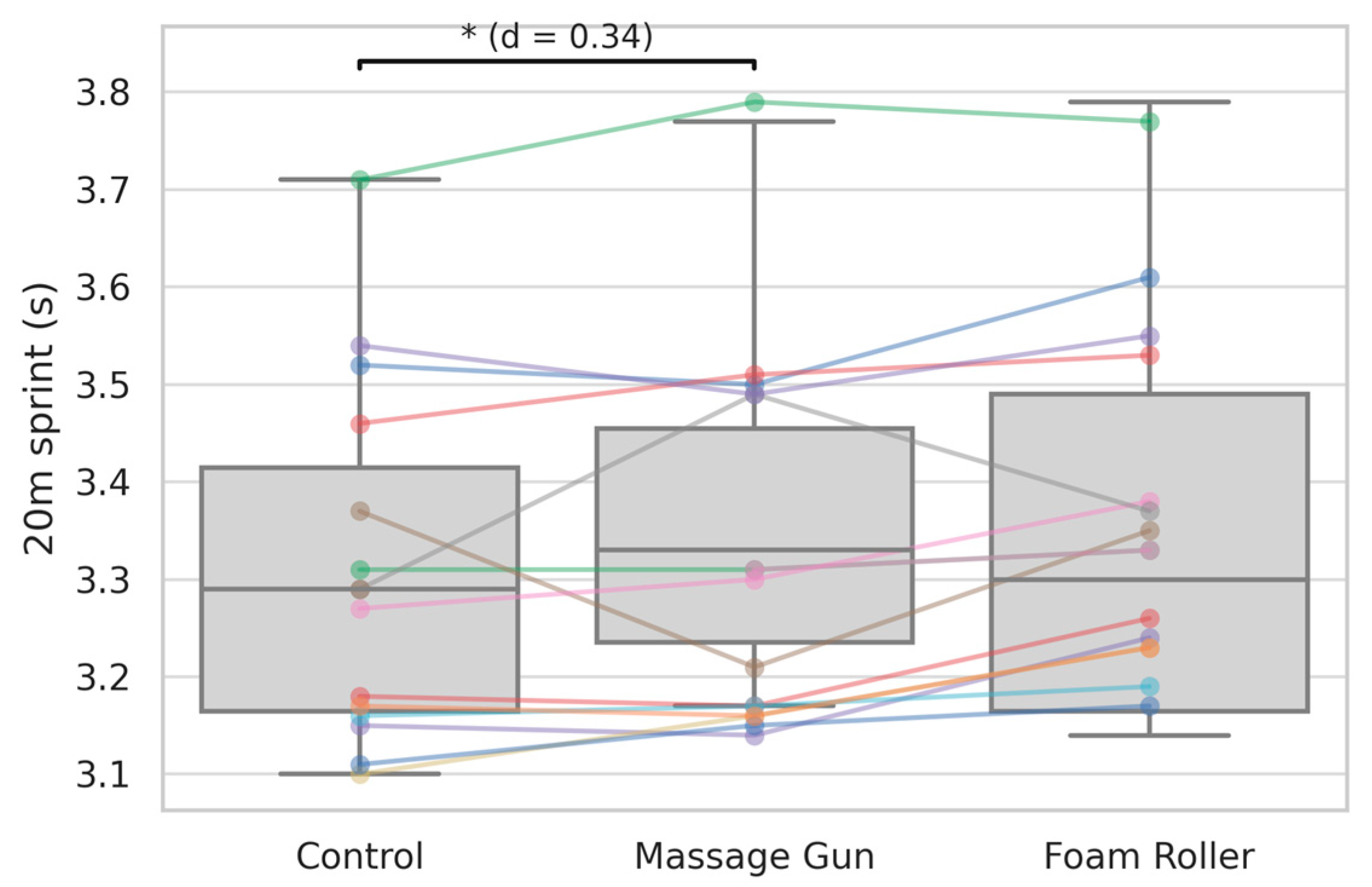
| Exercise | Reps |
|---|---|
| High knees | 20 |
| Butt kicks | 20 |
| Star jumps | 20 |
| Floor glute bridges | 8 |
| Deep bodyweight squat | 10 |
| Lunge and back w/overhead reach | 8 each side |
| CMJs 50–100% | 5 |
| Pogos | 20 |
| Variable | Con Mean ± SD | Gun Mean ± SD | Foam Mean ± SD | p-Value (LMM) |
|---|---|---|---|---|
| CMJ Jump Height (cm) | 36.24 ± 7.08 | 33.77 ± 6.83 * | 34.22 ± 6.82 # | <0.01 |
| CMJ RSImod | 0.47 ± 0.12 | 0.41 ± 0.10 * | 0.42 ± 0.11 # | <0.01 |
| 10/5 RSI | 1.48 ± 0.40 | 1.32 ± 0.35 | 1.43 ± 0.30 | 0.276 |
| 10/5 Contact time (ms) | 195.44 ± 28.61 | 207.81 ± 38.04 | 201.69 ± 40.58 | 0.447 |
| 10/5 Flight Time (ms) | 461.07 ± 49.77 | 456.40 ± 55.03 | 475.40 ± 43.50 | 0.348 |
| 20 m sprint (s) | 3.31 ± 0.18 | 3.37 ± 0.17 * ^ | 3.32 ± 0.19 ^ | <0.01 |
| Ankle Mobility L (cm) | 12.30 ± 2.53 | 12.83 ± 1.99 | 13.00 ± 1.91 # | 0.03 |
| Ankle Mobility R (cm) | 12.81 ± 2.35 | 13.16 ± 1.73 | 13.31 ± 1.86 | 0.11 |
| Variable | Con Mean ± SD | Gun Mean ± SD | Foam Mean ± SD | p-Value (LMM) |
|---|---|---|---|---|
| Muscle Soreness (/5) | 3.75 ± 0.45 | 4.12 ± 0.89 | 4.31 ± 0.79 # | <0.01 |
| Fatigue (/5) | 4.13 ± 0.81 | 4.06 ± 0.57 | 4.13 ± 0.89 | 0.960 |
Disclaimer/Publisher’s Note: The statements, opinions and data contained in all publications are solely those of the individual author(s) and contributor(s) and not of MDPI and/or the editor(s). MDPI and/or the editor(s) disclaim responsibility for any injury to people or property resulting from any ideas, methods, instructions or products referred to in the content. |
© 2025 by the authors. Licensee MDPI, Basel, Switzerland. This article is an open access article distributed under the terms and conditions of the Creative Commons Attribution (CC BY) license (https://creativecommons.org/licenses/by/4.0/).
Share and Cite
Ormeno, L.; Driller, M. Does Massage Gun or Foam Roller Use During a Warm-Up Improve Performance in Trained Athletes? Sports 2025, 13, 282. https://doi.org/10.3390/sports13090282
Ormeno L, Driller M. Does Massage Gun or Foam Roller Use During a Warm-Up Improve Performance in Trained Athletes? Sports. 2025; 13(9):282. https://doi.org/10.3390/sports13090282
Chicago/Turabian StyleOrmeno, Lachlan, and Matthew Driller. 2025. "Does Massage Gun or Foam Roller Use During a Warm-Up Improve Performance in Trained Athletes?" Sports 13, no. 9: 282. https://doi.org/10.3390/sports13090282
APA StyleOrmeno, L., & Driller, M. (2025). Does Massage Gun or Foam Roller Use During a Warm-Up Improve Performance in Trained Athletes? Sports, 13(9), 282. https://doi.org/10.3390/sports13090282







